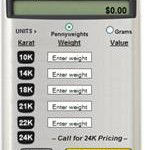Troy ounce refers to the weight standard used to measure precious metals on the world’s markets. Whenever an “ounce” of gold is mentioned, Troy ounce is implied – not the Avoirdupois ounce most American’s use when weighing food on a food scale. There are 28.3 grams to an Avoirdupois ounce – but there are 31.1 grams to a Troy Ounce.
Troy ounce pertains to the weight of the gold regardless of purity. For example, you can have one troy ounce of 14K gold. But, with regards to silver, troy ounce only pertains to silver which is .999 pure.
It is believed the term Troy ounce originated in the French city of Troyes during the middle ages where it was used during annual fairs as a weight measurement. This measurement system based on the Roman monetary system and used in the British Isles contains units in grains, pennyweights, Troy ounces and Troy pounds.
Using the term “Troy” when referring to the weight of gold jewelry is often confusing to the general public since the terms ounce and grams are common to Troy and Avoirdupois measurements. To avoid misunderstandings regarding weights, current gold prices and

GoldFellow®’s prices for scrap gold, we prefer to post our pricing in pennyweight. There are simply twenty pennyweights to one troy ounce of precious metal. If a customer wants to compare prices and needs our pennyweight prices converted to gram prices, there is an easy formula to convert grams into pennyweights and visa verse – but the simplest thing to do is to take advantage of GoldFellow®’s Gold Price Estimator which can price by pennyweight or grams.
Consumers who are still confused about troy weights and how to calculate the amount of cash for gold they will receive when they want to sell gold, should feel free to contact GoldFellow® gold buyers to discuss the value of their gold. Any of our customer service professionals will be happy to explain how scrap gold is weighed and priced – as well as convert grams to pennyweights for you.
References:








